| WAT TAKRAI (วัดตะไกร) |
| Wat Takrai or the Monastery of the Scissors is a restored ruin located off the city island in the northern area of Ayutthaya in Khlong Sra Bua Sub-district. The temple ruins are located west of Khlong Sra Bua (Lit: Canal of the Lilly Pond). The substantial site consists of an ordination hall, a vihara with large chedi, a prang, and several satellite chedis. The ordination hall (Th: ubosot) is a rectangular building, 16 meters long on 12 meters wide. There were two entries in the front and two in the back. The pedestal for the Buddha's image stood west, indicating the statue was looking to the east. The assembly or sermon hall (Th: wihan) is again a classic rectangular structure of 26 meters long and 12 meters wide. The building has porches in the front and in the back. There are three entries in the front. Also here the main Buddha image faces east as the pedestal stands in the west. The large principal chedi is bell-shaped and stands on an octagonal base. Between the spire (chatra) and the throne (harmika) is a kind of niche with stucco Buddha images, indicative of the use of the Sukhothai style in the reign of King Borommaracha II (r. 1424-1448) and Borommatrailokanat (r. 1448-1463). The prang in situ dates from the Late Ayutthaya period (1629 - 1767 AD). The base of the prang is higher than the body. There are about 15 small bell-shaped chedis with an octagonal base positioned north and south of the principal chedi. There are also two square ablution ponds made of brick in a north-south alignment, typical for this monastery. The monastic complex is surrounded by an outer wall (Th: Kampheang Kaeo or crystal wall), delimitating the monastic area. The wall measures 58 meters by 35 meters and had two gates, one at the east and one in the south. The temple former grounds were very extensive, stretching down to Khlong Sra Bua, creating a large courtyard needed for cremation ceremonies. Wat Takrai, located just north of Wat Na Phra Men, the crematory temple of the Royal palace was thus probably also a crematory temple. The monastery is mentioned in the ancient Ayutthayan poem Khun Chang Khun Phaen (the story of Khun Phaen, Khun Chang, and the fair Nang Wanthong), as the place where Wanthong was cremated after being executed by royal order and were Khun Chang and Phra Wai (her son with Khun Phaen) took temporarily their vows. "Saithong, who had been like her elder sister, recovered her senses and got up. She thought of Wanthong forlornly and tears splashed down in torrents. She took leave of Siprajan and went to board a boat, missing her terribly. She arrived at the capital and went straight to the house of Khun Phaen. She went into his room and asked, ‘Where’s Wanthong’s body?’Khun Phaen said, 'Buried at Wat Takrai.' He had someone take her there. Saithong descended from the ruean in tears. She pushed herself along in a daze. At the graveyard, her sobbing worsened and she collapsed down in a sad heap." [1] "Khun Chang got the robes and had his head shaved. Holding the robes with his hands in wai, he went in, opened his mouth, rolled his eyes and cried ‘uka.’ Then he trembled with nerves and mumbled. He got everything mixed up, and could not remember. 'Please tell it to me, Luangta Nu. I’ve never "uka" before. Please help.' He raised the triple robe to hide his face, and followed the recitation. He put on the robes, rolled the upper one on his shoulder, took the precepts, and came out. He stayed in the kuti at Wat Takrai for three nights, then disrobed and went to Suphan. After Wanthong's cremation was over, Phra Wai joyfully went to stay in the monkhood for seven days. After disrobing he went to attend on the king." [1] In the manuscript Testimony of the king from Wat Pradu Songtham, a document likely compiled in the Early Ratanakosin Period, is written that there was a land market from the frontage of Wat Takrai down to the frontage of Wat Na Phra Men. [2][3][4] Excavations indicate that this monastery was already built in the Early Ayutthaya Period (1350 - 1488 AD). The complex has been vacated during the Burmese war of 1766- 1767. In the Ratanakosin Period the temple has been used again in the reigns of King Rama IV (Mongkut) and Rama V (Chulalongkorn). The site is indicated on Phraya Boran Rachathanin's map drafted in 1926. The restored ruin of Wat Takrai is located in geographical coordinates: 14° 21' 55.45" N, 100° 33' 25.30" E. References: [1] The Tale of Khun Chang Khun Phaen - Siam’s Great Folk Epic of Love and War - Translated and edited by Chris Baker and Pasuk Phongpaichit (2010) - Chap 36: The execution of Wanthong. [2] Geographical description of Ayutthaya: Documents from the palace - Dr Winai Pongsripian - Bangkok (2007). [3] Note on the Testimonies and the Description of Ayutthaya - Chris Baker - Journal of the Siam Society, Vol. 99, 2011 - page 77 (paragraph on KWPS). [4] Markets and Production in the City of Ayutthaya before 1767: Translation and Analysis of Part of the Description of Ayutthaya - Chris Baker - Journal of the Siam Society, Vol. 99, 2011- page 52-3. |

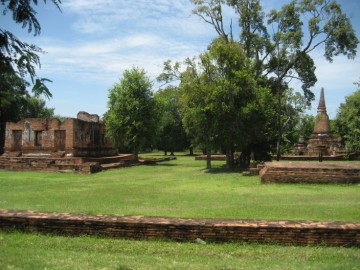
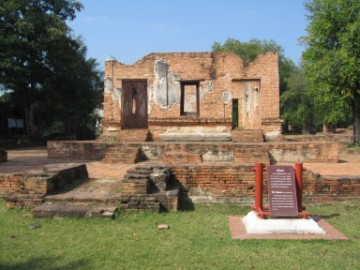
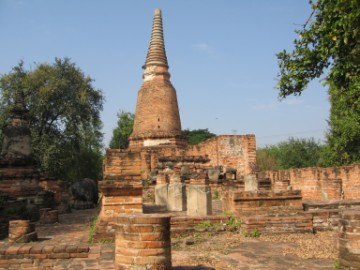
| Text by Tricky Vandenberg - November 2009 Updated August 2015 |
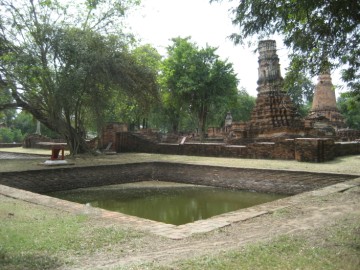
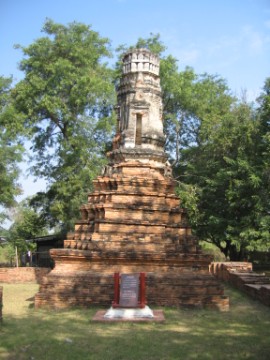
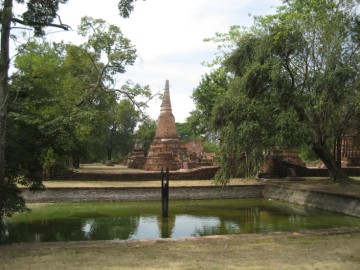
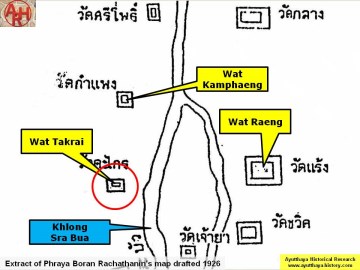
| (Detail of Phra Boran Rachathanin's 1926 map) |
| (View of Wat Takrai) |
| (The ordination hall of Wat Takrai) |
| (Main chedi of Wat Takrai) |
| (One of the two ponds in front of the vihara) |
| (One of the two ponds in front of the vihara) |
| (Prang in the Late Ayutthaya style) |
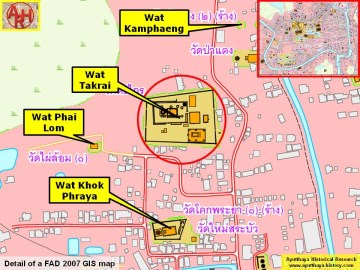
| (Detail of a 2007 Fine Arts Department GIS map - Courtesy of the Fine Arts Department - 3th Region) |


| (Source: Phra Rachawang lae Wat Boran nai Jangwat Phra Nakhon Sri Ayuthaya - 2511. Courtesy of the Fine Arts Department - 3th Region) |